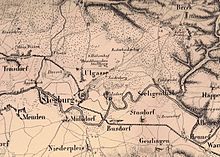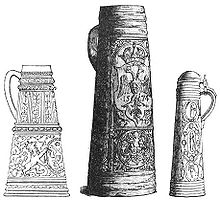Aulgasse

The Aulgasse is a former part of the city of Siegburg . The name is based on the old German term Ul for pot. Originally, this was the settlement of the Siegburg potters , who pursued their handicraft with kilns outside the city near the clay deposits there.
location
Aulgasse is located in the northeast of Siegburg's old town. Before the Thirty Years War , the settlement extended to the wooden gate on Holzgasse.
history
In a document dating back to 1322, the clay there was mined in large quantities on the Aulgasse and probably used there for burning. A hereditas, sita inter figulos (inheritance, located between the potters) is recorded for 1384 on Aulgasse , which is reproduced verbatim in a notarial deed of March 4, 1411 (income of the vicars of the parish church). At the beginning of the 15th century there was a village settlement here, in documents it is written in vico figulorum dicto uylgassen (called Ulgasse in the village of potters). In 1583 38 house owners were mentioned in a directory of the Aulgasser Rott People .
The main street called Aulgasse , a later part of the federal highway 484 , was blocked by a gate in the 15th century, where the Aulgasse toll had to be paid. At the time Aulgasse also to lay Michaelsberg Abbey belonging provost for Krucht .
The particularly light Siegburg clay was mainly processed into drinking vessels here, but was also shipped by ship to the Netherlands, where it was used to make pipes . The strict rules of the pottery guild only allowed limited production and regulated trade. This was mainly done through contracted merchants. The partially richly decorated stoneware was sold in Hamburg , on the Moselle , in Frankfurt and as far as South Tyrol .
Defective products were dumped on real dumps that could be explored in the course of archaeological excavations. The pottery products found there are proof of Siegburg's importance in the development and overall production of Rhenish ceramics .
In the conquest and three-year occupation of the town of Siegburg by Sweden in the Thirty Years' War , in which the Aulgasse 1632 pillaged was some pottery left the Aulgasse and settled in Altenrath on. Another reason was the strict guild discipline and the dependence on the monastery. In 1689, the Aulgasse was burned down again by French troops in the Palatinate War of Succession who wanted to drive out the regiments of the Munster cavalry positioned here from occupied Siegburg .
Few potters remained after these wartime events and the guild's skills were lost.
See also
Individual evidence
- ↑ Ursula Francke: Stoneware pottery in the 17th century in Troisdorf-Altenrath, Rhineland (accessed from Furnologia November 2010)
literature
- B. Beckmann: The shard hill in the Siegburger Aulgasse. Volume 1. The forms of ceramics from their beginnings to the beginning of the so-called heyday (periods 1 to 4). Bonn 1975
- JB Dornbusch: The potters ' art guild in the departmental city of Siegburg and their products, published by JM Heberle (H. Lemperß' sons), Cologne 1873, facsimile edition Rheinlandia, Siegburg 1986
Coordinates: 50 ° 48 ' N , 7 ° 13' E
